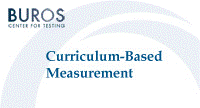Buros-Nebraska Series on Measurement and Testing

Curriculum-Based Measurement
Date of this Version
1993
Document Type
Article
Citation
Curriculum-Based Measurement, edited by Jack J. Kramer (Lincoln, NE: Buros Institute of Mental Measurements, 1993).
Abstract
In the history of Greek mythology there is a character named Sisyphus who, for sins committed during his lifetime, is condemned to spend eternity pushing a boulder up a hill. No matter how hard Sisyphus tries as he nears the top of the hill, the boulder rolls back down. Sisyphus cannot escape from this continued cycle of effort and failure. Sometimes, when I think about the experiences of many children attempting to learn basic skills in the public schools, I think of the myth of Sisyphus. Too often, it seems to me, no matter how hard they try, they do not succeed.
In this chapter on curriculum-based measurement (CBM) I want to focus on three points: First, what is curriculum-based measurement? Second, why was curriculum-based measurement developed? And third, how does the use of curriculum-based measurement help to avoid the problem of Sisyphus and education?
CURRICULUM-BASED MEASUREMENT DEFINED
As a Subset of Curriculum-Based Assessment
The term curriculum-based assessment (CBA) is a very popular topic in the field of special education these days (Tucker, 1985). As Tucker points out, CBA is a term used to describe a practice that has existed for a very long time-the practice of using what is to be learned as the basis for assessing what has been learned. Since traditional psychometric test construction also involves use of the table of specifications to define the content domains for which test items must be developed, the difference between CBA and traditional psychometric testing may not be immediately obvious. However, four salient differences between CBA and traditional psychometric testing can be identified: First, in CBA, the very curriculum materials that serve as the media for instruction are used as the test stimuli; second, direct observation and recording of student performance in response to selected curriculum materials are emphasized as a basis for collecting the information used to make assessment decisions; third, interobserver agreement is the primary technique used to establish the reliability of information collected through CBA; and fourth, social validity is typically the basis for justifying the use of information gathered through CBA. Given these emphases, it is common for CBA proponents to argue that the information gathered from student performance in the curriculum more adequately reflects the real goals of instruction in the classroom than most standardized achievement tests, because the assessment information obtained through CBA relates more directly to what is being taught, and also because the content and materials of daily instruction are a fairer and firmer basis for making judgments about student learning.
Since the focus here is on CBM, some clarification of the term is needed. The term assessment as used in CBA is a very broad term that refers to information gathered for purposes of decision making. Thus, curriculum-based assessment refers to all sorts of information-gathering practices that may occur when observing student performance in the curriculum. These practices include scoring the student's worksheets to obtain a percentage score for the problems or answers correctly completed on a worksheet; making judgments about a student's reading comprehension based on the prosodic features of that student' s oral reading; and moving the student to a new skill based on consecutive days of answering all questions correctly. In CBA, typically, different assessment information is collected for different decisions. A variety of different but related approaches to CBA are represented in the current literature (d. Howell & Morehead, 1987; Bigge, 1988; Idol, Nevin, & Paolucci-Whitcomb, 1986; Shinn, 1989).
Included in
Curriculum and Instruction Commons, Educational Assessment, Evaluation, and Research Commons


Comments
Copyright © 1993 by Buros Institute of Mental Measurements. Digital Edition Copyright © 2012 Buros Center for Testing. This book may be downloaded, saved, and printed by an individual for their own use. No part of this book may be re-published, re-posted, or redistributed without written permission of the holder of copyright.